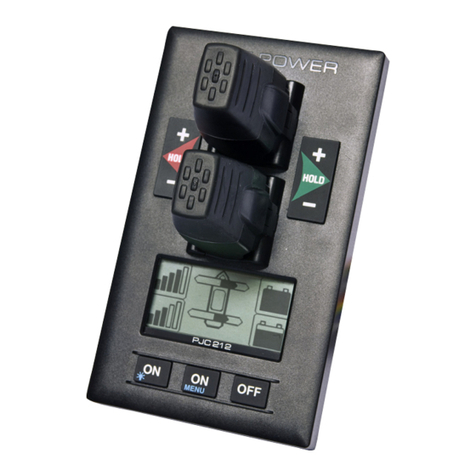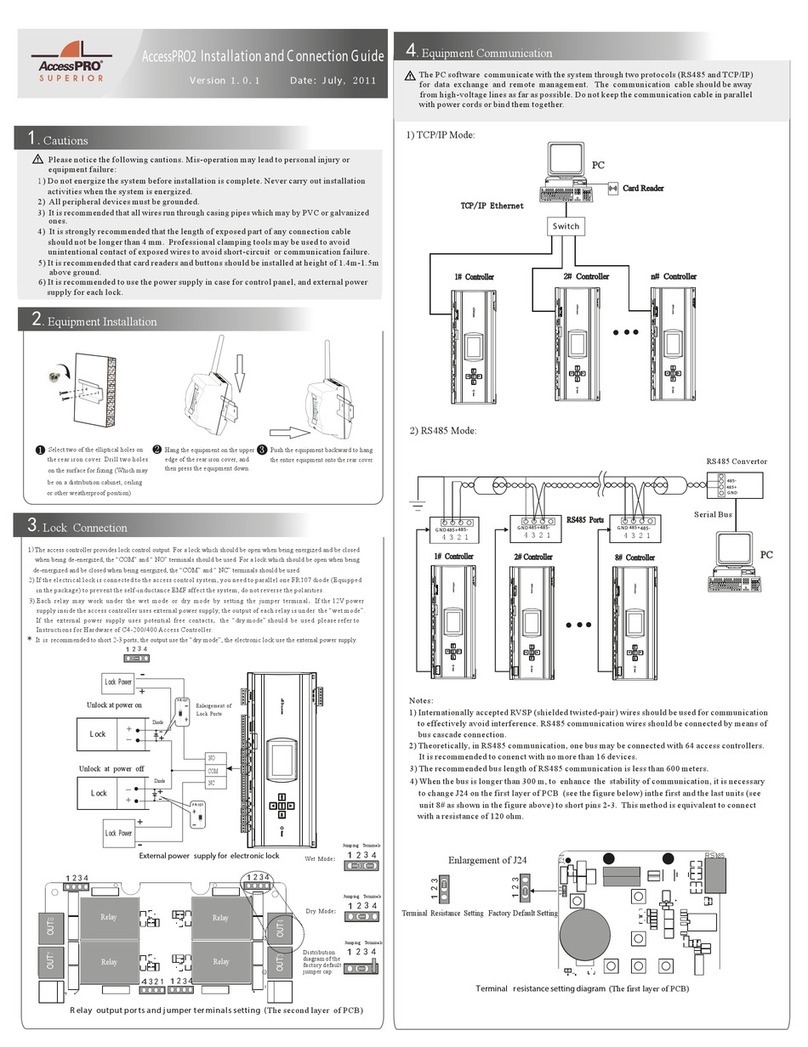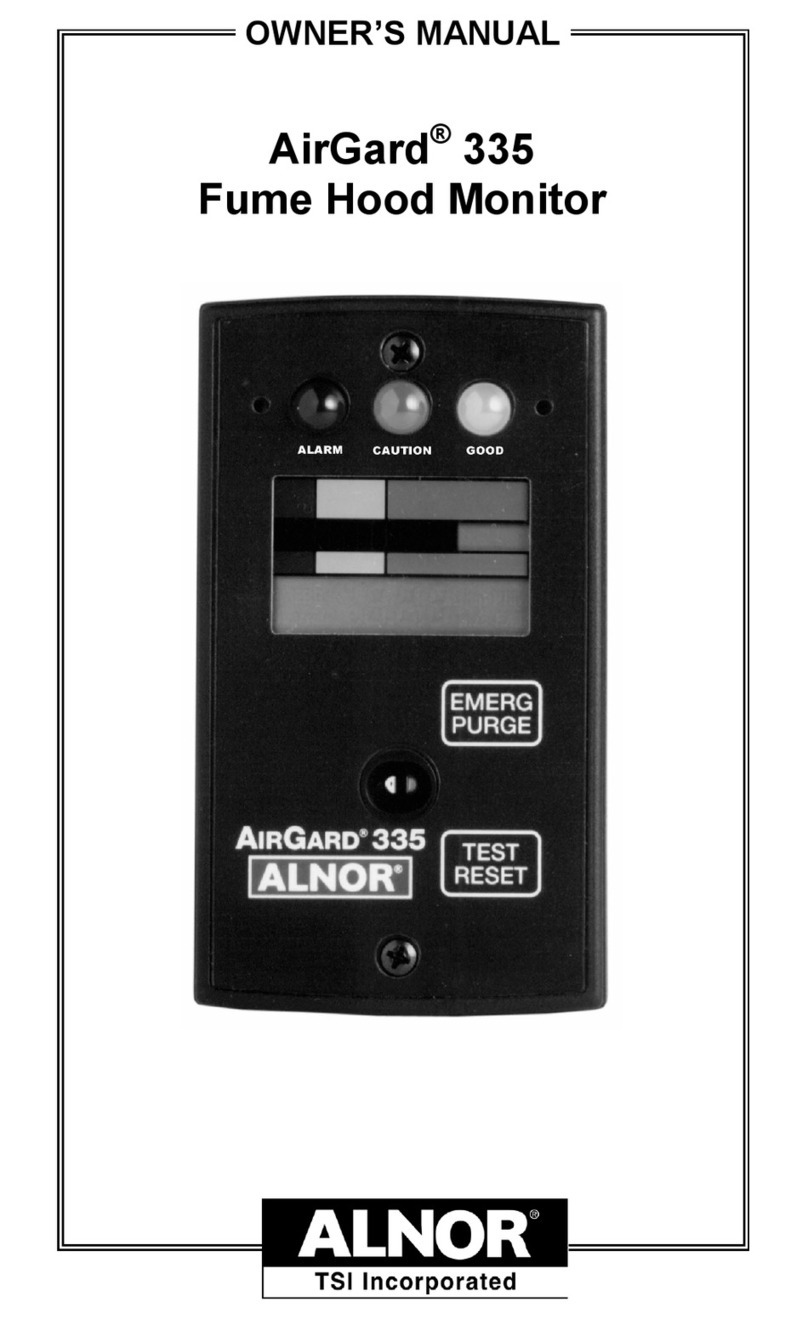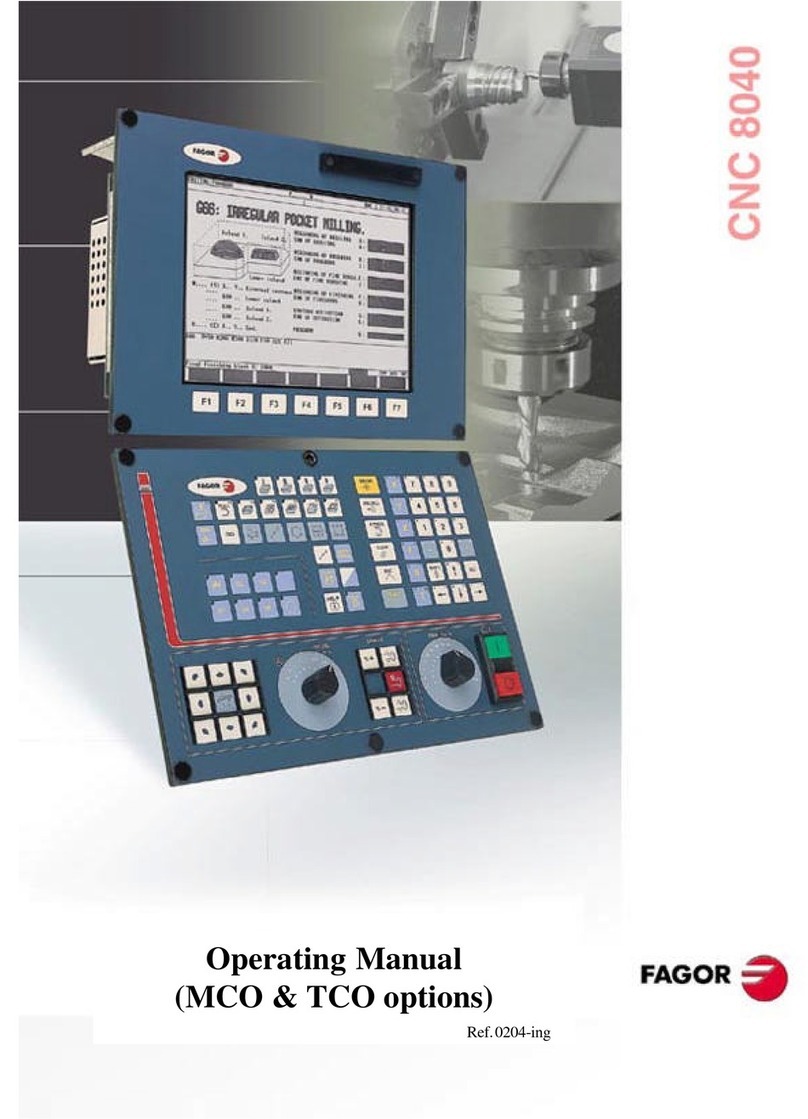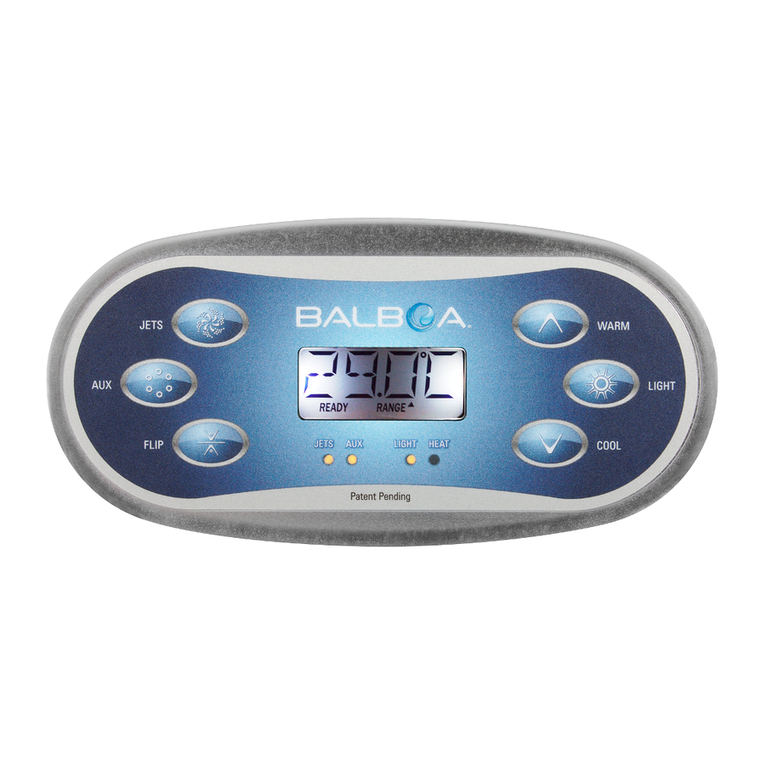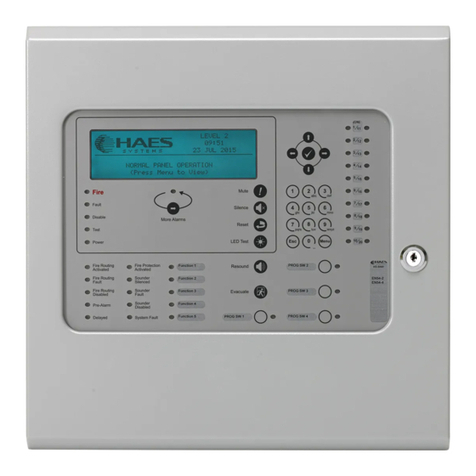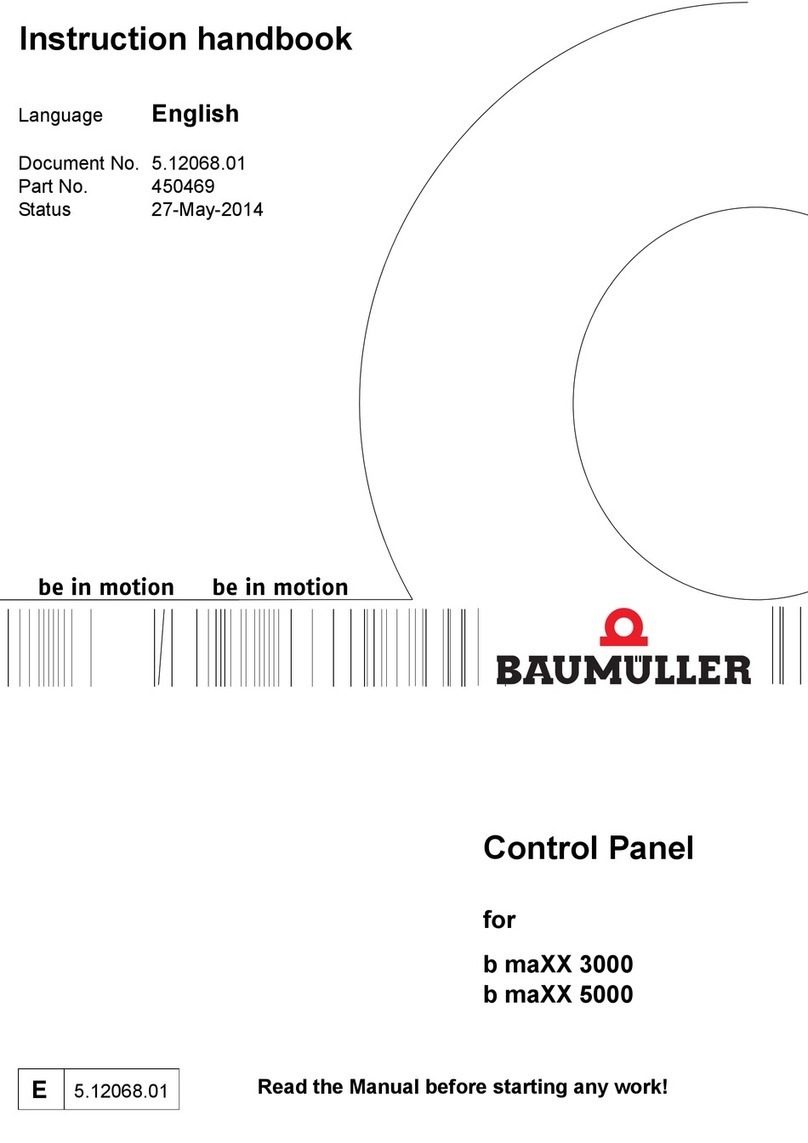TFS AdvantageLi User manual

Product part no. 830030 AdvantageLi Dual Zone Fire Control Panel
Manual part no 650.000050 rev August 20 2020
Installation, Operation and Maintenance Manual Revision History
Rev
Date
Revision
Author Brief Description
8/10/ 0 MR Finalized preliminary version
8/14/ 0 MR Final version released for publication
8/ 0/ 0 MR Revised superscript references, page numbers, font sizes, section
references
9/30/ 0 MR Printing instructions; Added QR Code
Printing Instructions – Do not print this page!
Paper info - 0# bond, 11” x 17” Booklet fold, 3-hole drill

Product part no. 830030 Advantage
Li
Dual Zone Fire Control Panel
Manual part no 650.000050 August 20 2020
Product part no. 830030 Rev. 8/20
Manual no. 650.000050 www.tfsnc.com
Product Operation and
Advantage
Li
Detection and Releasing
Lithium Battery Powered Fire Control Panel
Maintenance Manual

Product part no. 830030 AdvantageLi Dual Zone Fire Control Panel
Manual part no 650.000050 August 20 2020

Product part no. 830030 AdvantageLi Dual Zone Fire Control Panel
Manual part no 650.000050 August 20 2020
FireAway AdvantageLi Dual Zone Fire Control Panel
Installation, Operation and Maintenance Instructions
- Table of Contents -
1.0 AdvantageLi Dual Zone Control Panel Quick Overview
1.1 AdvantageLi Features
.0 Before Using the AdvantageLi Control Panel
.1 AdvantageLi Control Panel Warnings and Precautions
. AdvantageLi Control Panel Compliance Notice
3.0 AdvantageLi Installation
3.1 Representative Field Wiring
3. AdvantageLi Field Wiring Requirements
3.3 Pluggable Terminal Strip Connections
3.4 AdvantageLi Complete Wiring Connection Table
4.0 AdvantageLi Control Panel Operation
4.1 AdvantageLi Field Wiring and Control Panel Functions
Power Input Circuits
Initiating (Detection) Circuits Operation
Actuation Circuits Operation
Auxiliary Supervised Circuit Operation
Abort Function Supervised Circuit Operation
Input-Output (I/O) Relay Operation
Local Audible Buzzer Operation
LED Visible Annunciation Operation
Internal Clock
System Event Log
4. Normal Operation
4.3 AdvantageLi Default Settings
4.4 Alarm Condition Operation
4.5 Trouble Condition Operation
4.6 Alarm Test, Alarm Silence & Alarm Reset Testing
4.7 Front Panel Switch Operation
4.8 Detection, Actuation and Relay Operation
5.0 AdvantageLi Maintenance
Initial Inspection
Periodic Inspection
Visual Inspection
Annual Battery Replacement
6.0 Troubleshooting & Customer Support Info
6.1 Diagnostic Guide
6. Flash Code Troubleshooting Table
7.0 AdvantageLi Control Panel System Programming

Product part no. 830030 AdvantageLi Dual Zone Fire Control Panel
Manual part no 650.000050 August 20 2020
8.0 Appendix and Notes
8.1 Miscellaneous Practical and Technical Notes
8. Installation and System Performance Document
8.3 High Temperature Operation
8.4 Spare and Replacement Parts List
8.5 AdvantageLi Product Data Sheet
9.0 Product Warranty

Product part no. 830030 AdvantageLi Dual Zone Fire Control Panel
Manual part no 650.000050 1 August 20 2020
AdvantageLi Dual Zone Control Panel Quick Overview
The AdvantageLi Dual Release Zone, Dual Battery Control Panel part no. 830030 is the result
of years of rugged mining, transit, and military electronic control panel evolution and design
experience. The AdvantageLi control panel uses lithium thionyl chloride batteries that operate
for up to one year on the primary battery and includes an identical secondary backup battery
as a UL required backup power source.
The AdvantageLi control panel can operate to protect a single fire detection and suppression
hazard or can provide up to two separate zones of fire detection and suppression. Two wire
Class B supervision is provided for detection, manual release, and auxiliary zones. The
AdvantageLi control panel supports spot thermal, linear thermal and relay base smoke
detectors on each of two detection input zones. The AdvantageLi control panel can be
programmed using a PC interface and cable to customize detection and releasing zone
mapping including cross zoning and auxiliary relay timing and operation. Lithium thionyl
chloride batteries are DOT approved for overnight shipping when not bulk packed.
Multiple auxiliary optically isolated relays provide up to 1/ amp switching capability and can
interface to auxiliary relay modules for additional switching and logic functions. The auxiliary
relay modules provide high current switching capability for solenoid operated gas valves,
remote fans, etc. A dedicated set of Fire Alarm Control Panel (FACP) contacts are provided,
which allow supervision of the control panel by remote FACP’s or other control devices. The
AdvantageLi panel is constructed using RoHS compliant materials and production methods
throughout.
A variety of detection input devices and remote annunciators are available. The AdvantageLi
control panel may be directly mounted, recessed, or assembled to a DIN rail installation.
Separate mounting bracket hardware is available.

Product part no. 830030 Advantage
Li
Dual Zone Fire Control Panel
Manual part no 650.000050 2 August 20 2020
1.1 Advantage
Li
Features
Control Panel Exterior Features
The Advantage
Li
enclosure material is fiberglass reinforced polycarbonate and is listed
as UL508/NEMA Type 4X with an IP-67 Rating and a UL-94V0 flammability rating. A
locking hasp is provided for end-user security purposes. Two types of wiring hubs are
available. The Advantage
Li
part no. 830030 uses qty (3) ½” die cast liquidtight metal
flex conduit wiring hubs. The Advantage
Li
part no 830030-01 uses qty (3) ½” liquidtight
plastic convoluted tubing wiring hubs.
A front mounted local audible buzzer provides a pulsed alarm of approx 90 dB at 900
Hz. The audible buzzer operates during Trouble and Alarm conditions.
Figure 2 - Advantage
Li
Internal Features
Figure 1 - Advantage
Li
External Features

Product part no. 830030 AdvantageLi Dual Zone Fire Control Panel
Manual part no 650.000050 3 August 20 2020
.0 Before Using the AdvantageLi Control Panel
.1 AdvantageLi Control Panel Warnings and Precautions
Warning!
The AdvantageLi Control panel must be installed by a technician familiar with Fire Control
panel operation and who has been trained in the operation of the AdvantageLi control panel.
Warning!
The AdvantageLi control panel is designed to meet the requirements for special hazard
locations. This control panel will not comply with local authority requirements for a UL 864
listed control panel.
Warning!
The fire detection and suppression system shall be designed in accordance with the
requirements of the local Authority Having Jurisdiction and in accordance with all local and
national codes and ordinances.
Warning!
The Manual Release circuit will override the Abort Switch operation.
Caution!
The AdvantageLi actuation circuits must be routed inside of approved protective conduit to
prevent physical damage to the wiring. Actuation circuits must use 16-18 awg wire no
longer than 100 feet per circuit.
Notice
The AdvantageLi control panel is designed to meet the performance and operating standards
of UL864, which requires the use of AC main power and a rechargeable secondary power
source. The AdvantageLi control has been extensively tested over extended periods in
extreme environments using lithium thionyl chloride non-rechargeable batteries.
Notice
Prior to installation of the AdvantageLi control panel refer to NFPA 7 chapter 7 for
documentation requirements.

Product part no. 830030 AdvantageLi Dual Zone Fire Control Panel
Manual part no 650.000050 4 August 20 2020
. AdvantageLi Control Panel Compliance Notice
The AdvantageLi Control Panel is designed per NFPA 17, NFPA 70, NFPA 7 and NFPA
010 standards for installation, operation, and maintenance.
Product Type: Releasing Device
Power Limited Circuits: All circuits are power limited
Supervised Circuits: Initiating (Detection), Actuation, Auxiliary, Abort
Battery Information: This control unit is designed using qty ( ) lithium thionyl chloride
batteries as both the primary and secondary power source. Use only FireAway
Advantage-Lithium Battery part no. 830031 as replacement.
Battery Disposal: Do not incinerate, or subject cells to temperatures in excess of 100oC.
Such abuse can result in loss of seal, leakage, and/or cell explosion. Dispose of in
accordance with appropriate local regulations.
SDS Sheet available by contacting http://tfsinc.com
Emergency Contact:
Chemtrec 1-800-4 4-9300
1-703-5 7-3887
Transportation of Lithium batteries and devices that contain lithium batteries is
closely regulated. Regulations change periodically. Be sure to refer to
International Air Transport Association (IATA) requirements (http://iata.org).
The battery included with the AdvantageLi control panel is a non-rechargeable,
lithium metal battery. When shipped separate from the AdvantageLi control panel
its outer packaging should be labeled to include reference to UN3090 Lithium
Metal Batteries listed as Hazard Class 8.
When the battery is shipped as included with the AdvantageLi control panel, the
outer packaging should be labeled to include reference to UN3091 – Lithium
Metal Batteries Contained in Equipment or Lithium Metal Batteries Packed with
Equipment listed as Hazard Class 9.
The battery packs are DOT tested for construction compliance and rated as
35413 4BAT-001 per UN Manual of Test and Criteria, Part III, sub-section 38.3.

Product part no. 830030 AdvantageLi Dual Zone Fire Control Panel
Manual part no 650.000050 5 August 20 2020
3.0 AdvantageLi Installation
3.1 Representative Field Wiring
Figure 3- AdvantageLi Representative Field Wiring
3. AdvantageLi Field Wiring Requirements
Circuit
Maximum
Length
Max Linear
Resistance
(ohms)
Wiring
Cross
Section
Terminating
Resistor
ohms
Pluggable
Terminal
Strip Screw
Torque
Wire
Strip
Length
Detection 400’ 50 16-18
awg
470k 5 in-lbs.
(0.5 – 0.6
nm)
0. 75”
7mm
Manual Release 400’ 50 “ “ 470k “ “ “ “
Actuation 100’ 1 “ “ n/a “ “ “ “
Auxiliary 400’ 50 “ “ closed “ “ “ “
Abort 400’ 50 “ “ 470k “ “ “ “
I/O’s n/a n/a n/a n/a “ “ “ “
Wiring Notes:
All wiring connections must be terminated using watertight connections
Actuator/generator wiring must be connected in series and routed in protective conduit

Product part no. 830030 Advantage
Li
Dual Zone Fire Control Panel
Manual part no 650.000050 6 August 20 2020
3.3 Pluggable Terminal Strip Connections

Product part no. 830030 Advantage
Li
Dual Zone Fire Control Panel
Manual part no 650.000050 7 August 20 2020

Product part no. 830030 AdvantageLi Dual Zone Fire Control Panel
Manual part no 650.000050 8 August 20 2020
3.4 AdvantageLi Complete Wiring Connection Table
Connector – Pin i.d.
Row A
–
Top
Circuit Function
Circuit Notes
A-1 Detection Zone 1 (+) Class B with 470K EOL
A- Detection Zone 1 (-) “
A-3 Detection Zone (+) “
A-4 Detection Zone (-) “
A-5 Manual Release Switch (+) “
A-6 Manual Release Switch (-) “
A-7 Actuation Zone 1 (+) 0 to -ohm series supervision
A-8 Actuation Zone 1 (-) “
A-9 Actuation Zone (+)
“
A-10 Actuation Zone (-)
“
A-11 Auxiliary Input (+) Normally Closed, Trouble when open
A-1 Auxiliary Input (-) “
A-13 Abort Switch (+) Class B with 470K EOL
A-14 Abort Switch (-) “
Connector – Pin i.d.
Row B – Bottom
Circuit Function
Circuit Notes
B-1 NC - Relay 1
Maximum ½ amp at 30 VDC
B- Common - Relay 1 “
B-3 NO - Relay 1
“
B-4 NC - Relay
“
B-5 Common - Relay “
B-6 NO - Relay
“
B-7 NC - Relay 3
“
B-8 Common - Relay 3 “
B-9 NC FACP Trouble Alarm – Relay 4 Remote FACP supervisory relay
B-10 Common FACP Trouble Alarm – Relay 4
B-11 Remote FACP EOL Resistor – Relay 4 & 5
“
B-1 Remote FACP EOL Resistor – Relay 4 & 5 “
B-13 NO FACP Fire Alarm – Relay 5 “
B-14 Common FACP Fire Alarm – Relay 5 “

Product part no. 830030 AdvantageLi Dual Zone Fire Control Panel
Manual part no 650.000050 9 August 20 2020
4.0 AdvantageLi Control Panel Operation
4.1 AdvantageLi Field Wiring and Control Panel Functions
Power Input Circuits
Power to the control panel is provided by two separate battery packs designated as
primary and secondary power. Both power sources are supervised for presence and
voltage. Expected operating life of each battery pack operating under normal conditions
is one year assuming no Fire or Trouble conditions have occurred. Battery packs must
be replaced if either a Fire or Trouble condition occur. After a one-year time period, the
primary pack must be replaced. The secondary battery may then be transferred to the
primary position and a replacement pack added to the secondary position. Expected
shelf life for the battery pack is 10 years. A date code label provided is used to indicate
the installation and expiration of each battery pack. This label is installed at the time of
system commissioning and during maintenance.
If the primary battery becomes depleted or if any battery fault condition occurs, operation
automatically switches to the secondary battery. No operator intervention is required.
A Trouble condition will exist when switching from primary to secondary battery power
The Battery Fault LED will turn ON, pulse the local audible buzzer and will transfer a
trouble relay if programmed. The AdvantageLi will continue to provide fire detection and
suppression while operating on the secondary battery for approximately two weeks after
the primary battery fault condition is first indicated.
Initiating (Detection) Circuits Operation
Default detection settings are programmed such that any detection input will actuate all
actuation outputs. Additional detection/actuation mapping options are available via PC
based configuration menu. Options for cross-zoning, individual detection to actuation
and the ability to disable individual detection and actuation zones are available. See
section 7.0 for offline PC programming information.
Two automatic detection circuits and a single dedicated manual release circuit are
classified as Class B Style 4 with a 470K end-of-line device providing circuit supervisory
resistance. Trouble conditions occur if the circuit resistance drops out of tolerance or
increases out of tolerance. A Fire condition is indicated when the detection circuits drop
in resistance to a predetermined fire detection level.
Any normally open fire detecting device (linear thermal wire, spot thermal sensors,
smoke detectors, etc.) may be used when terminated with a 470K end-of-line device
provided with the control panel. Refer to the individual sensor manufacturer instruction
for installation, operation, and maintenance of the sensor.
To conserve battery life, detection circuits are periodically monitored approximately
every three seconds. The manual release switch input is monitored more frequently
than the automatic detection circuits and will respond more rapidly.

Product part no. 830030 AdvantageLi Dual Zone Fire Control Panel
Manual part no 650.000050 10 August 20 2020
Actuation Circuits Operation
Two actuation circuits are each capable of actuating up to six Stat-X aerosol generators
or similar devices on two separate zones. Power to fire the actuators is delivered from a
bank of super capacitors. Upon Fire detection, the control panel provides a signal to fire
from the fully charged supercapacitor bank. Discharge is immediate with no capacitor
charging delay.
Auxiliary Supervised Circuit Operation
An auxiliary normally open pair of contacts are available for use. This input is normally
closed and opens in alarm. Pressure switches, water alarms and door closures are
some examples of auxiliary supervised devices. A Trouble condition occurs if the
auxiliary circuit changes from closed to open. If an open condition occurs, a Trouble
condition is annunciated via the yellow Service System LED. The auxiliary function is
programmed to be OFF by default. Offline PC programming may be used to change the
auxiliary contact setting to ON.
Abort Function Supervised Circuit Operation
An Abort function switch interrupts the automatic detection/automatic actuation process
if a discharge time delay is programmed. The Abort function contacts are supervised via
a 470K end-of-line resistor. If the Abort Switch closes, the abort function will delay the
system discharge if a discharge has been programmed. The Abort function is
programmed to be OFF by default. Offline PC programming may be used to change the
Abort function to ON.
Manual release input overrides the Abort function.
Warning!
The Abort function serves to delay the discharge process and will not prevent a
discharge once a fire has been automatically detected. The Abort function serves to
allow evacuation of personnel if a fire alarm has been detected.
Input-Output (I/O) Relay Operation
Multiple sets of optically isolated, relay contacts are available for use as inputs and
outputs and are intended for use in controlling external relays or other annunciation
devices.
A single set of dedicated relay contacts are provided to allow for remote supervision of
the AdvantageLi by a remote fire alarm control panel (FACP). Dedicated FACP relay
contacts allow for an end-of-line resistor which can be monitored by a remote FACP.
NO-Fire and NC-Trouble sets of contacts may be wired to a remote FACP. This allows
the remote FACP the ability monitor the status of the AdvantageLi for both Trouble and
Fire conditions.
Other I/O’s consist of ( ) separate optically isolated outputs which may be used for pre-
alarm and alarm indication. Output transfer from is adjustable in five second increments
from 0 to 30 seconds via offline PC programming. Output control contacts control may
be mapped to individual detection inputs. Both sets of relay contacts may be

Product part no. 830030 AdvantageLi Dual Zone Fire Control Panel
Manual part no 650.000050 11 August 20 2020
programmed for momentary transfer by pressing the front panel Reset Switch. This
function may be used for interrupting power to latching function initiating devices
(latching relay base smoke detectors). All I/O contact ratings are ½ amp at 30 VDC.
Relays 1 & – Normally Closed/Common & Normally Open/Common
Relay 3 – Normally Closed/Common
Relay 4 – Fire Alarm Control Panel (FACP) Interface
Local Audible Buzzer Operation
A supervised local piezo buzzer is located on the control panel front cover. The buzzer
provides an audible alarm in the event of a Fire or Trouble condition. A push button is
located on the inside of the control panel, which may be used to silence the audible
alarm. An LED indicator illuminates when the silence enable function is operated. The
silenced audible alarm will turn On if the Fire or Trouble condition has not been cleared
AND after the audible has been silenced for six hours OR if a new Trouble or Alarm
condition is detected. The alarm silence function cannot be engaged prior to an alarm
condition.
LED Visual Annunciation Operation
Visual LED indications are visible through a window on the hinged front cover. LED
indications are visible for:
System Normal (green)
Fire Alarm Detection Zone 1 (red)
Fire Alarm Detection Zone (red)
Manual Release Fire Alarm (red)
Trouble Condition Service System LED (yellow)
Battery Fault LED (yellow)
Alarm Silence LED (yellow)
A key lock position is provided to prevent access and tampering to internal components
by unauthorized individuals. Upon opening the front cover, the Alarm Silence, System
Reset, Push-to-Test push buttons, and System Disable toggle switches may be
accessed.
The Alarm Silence push button only active when the audible alarm is ON. The audible
alarm cannot be pre-silenced.
The System Reset push button will clear all latched alarms and latched relay outputs
once the circuit causing the Alarm condition has been cleared and returned to Normal
Operation.
The Push-to-Test button will illuminate all LEDs and sound the audible alarm, but will not
transfer relays.

Product part no. 830030 Advantage
Li
Dual Zone Fire Control Panel
Manual part no 650.000050 12 August 20 2020
Internal Clock
A real-time clock is present and should be set when the system is commissioned. The
clock is backed up by a supercapacitor, which may lose voltage if the control panel
remains unpowered for extended periods beyond a few days. The internal clock may be
set via PC connection to the circular front panel programming port. See section 6 for
programming instructions.
System Event Log
A system Event Log is used to capture non Normal conditions or other actions that occur
while the Advantage
Li
is in operation. Events such as field wiring faults, system reset,
alarm silence, set clock, etc. are recorded. Events are time stamped and each event
description is identified. The Event Log is sequential with the most recent events listed
at the top of the log. The Event Log buffer is capable of storing 100 events. The oldest
events are replaced by the most recent events.
4. Normal Operation
Advantage
Li
Startup Process
When the Advantage
Li
panel is initially powered up or if batteries have been replaced,
the panel enters a startup mode which may consist of several minutes depending on the
state of internal capacitor charge and battery age and condition.
Startup consists of a sequence of internal processes. The particular step in the startup
process is indicated by the front panel LEDs as follows ...
Green LED ON for approximately 5 seconds – Begin boot loader mode
All LEDs flash x – End of boot loader mode
All LEDs flash simultaneously – Battery conditioning mode
Note – the battery conditioning mode may extend for several minutes as the
batteries are prepared for operation
Green LED flashes quickly - Actuation capacitor bank is precharging
All LEDs flash 3x – End of capacitor charge mode
Slow green LED flashes 1x every 5 seconds – Normal operation
Figure 3 - Advantage
Li
Start Up Sequence
Figure 4 - Advantage
Li
Capacitor Charge and Normal Operation

Product part no. 830030 AdvantageLi Dual Zone Fire Control Panel
Manual part no 650.000050 13 August 20 2020
4.3 AdvantageLi Default Settings
The AdvantageLi allows for a variety of programming options as described in section 7.
The AdvantageLi default settings for detection, actuation and relay operation are as
follows:
Advantage
Li
Default
Configuration
Detection Zone Enabled?
Actuation Zone Delay
Zone 1 Yes 1 0
Zone Yes 0
Manual Release Yes Both 0
Auxiliary Input No N/A N/A
Abort Switch No N/A N/A
Relay 1 - FACP Alarm Output Yes Any Alarm 0
Relay - FACP Trouble Output Yes Any Trouble 5
Relay 3 Yes Any Alarm 0
Relay 4 Yes Any Alarm 0
Relay 5 Yes Any Alarm 0
4.4 Alarm Condition Operation
If an Alarm condition occurs on any automatic detection zone,
The green System Normal LED will turn OFF,
The buzzer will begin to pulse,
The particular alarm zone will be indicated by the Alarm Zone red LED
flashing ON,
Depending on detection-actuation mapping, the mapped actuation zone
will fire,
Depending on actuation-relay mapping, the mapped relay(s) will transfer,
The sequence of events (Fire by zone, Actuation by zone, etc.) are
recorded, and time stamped in the Event Log
If the manual release circuit is initiated,
The green System Normal LED will turn OFF,
The buzzer will begin to pulse,
Both alarm zones will be indicated by the Alarm Zone red LED flashing
ON,
Depending on detection-actuation mapping, the mapped actuation zones
will fire,
Depending on actuation-relay mapping, the mapped relay(s) will transfer,
The sequence of events (Fire by zone, Manual Release, Alarm Silence,
etc.) are recorded, and time stamped in the Event Log

Product part no. 830030 AdvantageLi Dual Zone Fire Control Panel
Manual part no 650.000050 14 August 20 2020
4.5 Trouble Condition Operation
If a Trouble condition occurs with any of the field wiring or internally supervised circuits,
a Trouble condition is displayed on one of the front panel LEDs
Field wiring circuits include a minimum five second time delay before a Trouble condition
is annunciated. If the Trouble condition resets to Normal before the five second delay
times out, no Trouble will be annunciated, or event logged.
All Alarm and Trouble conditions are annunciated via an LED flash code sequence. The
flash code displayed by the Service System LED and corresponds to the indicated zone
and condition I.D. The flash code list is printed on the front panel label of the
AdvantageLi electronics module.
Press and hold the Push to Test button to read the diagnostic flash code.
Diagnostic flash codes are as follows:
Service System
Flash Code Description
1X Detection Zone 1
X Detection Zone
3X Manual Release Zone
4X Actuation Zone 1
5X Actuation Zone
6X Auxiliary Switch
7X Actuation Disable
8X Local Buzzer
9X Ground Fault
10X Abort Switch Fault
11X Cross Zone Fault
1 X Temperature Fault
Other LED Indicators Description
Battery Fault Battery Fault

Product part no. 830030 AdvantageLi Dual Zone Fire Control Panel
Manual part no 650.000050 15 August 20 2020
4.6 Alarm Test, Alarm Silence and System Reset Testing
The Alarm features of the AdvantageLi can be tested using a number of methods.
1) Push to Test
a) The front panel located Push to Test button can be pressed which will flash all of
the LEDs ON, sound the audible buzzer but will not transfer I/O relays.
) Field wiring sensor test,
a) Make sure all actuation devices are disconnected and replaced with alarm
simulators or equivalent.
b) Simulate a contact closure on each of the detection circuits.
c) Verify the proper zone is in alarm.
d) Press the Alarm Silence button.
e) The audible buzzer will silence, and the Alarm Silence LED will be ON. Clear
the Alarm condition by reopening the initiating circuit contact and the Alarm
Silence LED will turn OFF.
f) A Trouble condition will be displayed.
g) Press the System Reset button and reset the simulated actuation devices.
h) Trouble will clear and the AdvantageLi will return to Normal operation.
4.7 Front Panel Switch Operation
Two separate toggle switches are located on the front of the AdvantageLi control panel.
1) Actuation Disable
a. The Actuation Disable toggle allows for system maintenance by disconnecting
both actuation circuits from Normal operation. A Trouble indication is present
when the Actuation Disable switch is engaged. The audible alarm will pulse 1X
every 4 seconds.
b. If an Alarm condition exists, the AdvantageLi indicates an Alarm, but will not fire
the actuation circuits. If the AdvantageLi remains in alarm and the Actuation
Disable toggle is reset, the panel will remain in an Alarm/Trouble condition and
will not fire the actuators.
c. The AdvantageLi control panel will not operate when the Actuation Disable switch
is in the Actuation Disable – ON position.
d. Actuation Disable is recorded as a system event
This manual suits for next models
1
Table of contents
Popular Control Panel manuals by other brands

Johnson Controls
Johnson Controls S1-TTSCC01 Technical guide
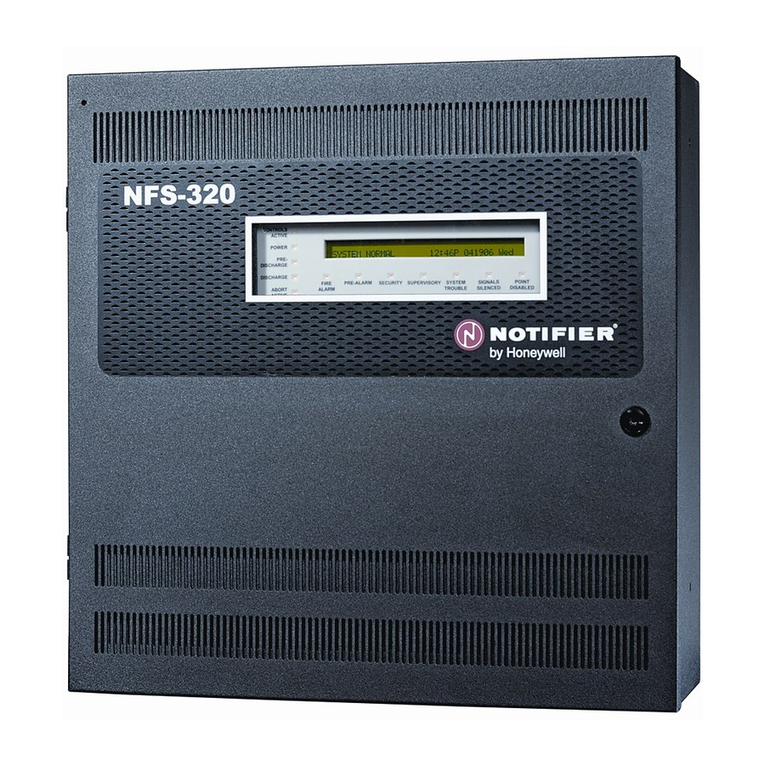
Notifier
Notifier NFS-320 installation manual

Elk Products
Elk Products ELK-M1G Installation and programming manual
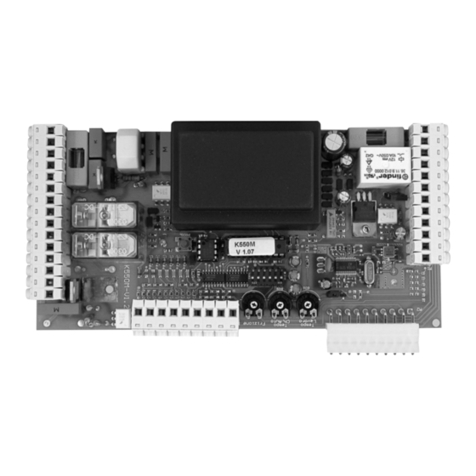
tau
tau K550M installation guide
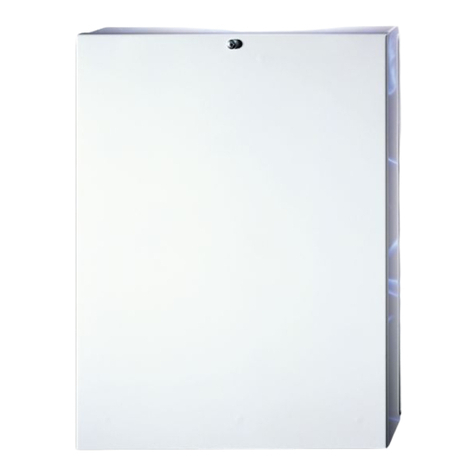
Texecom
Texecom PREMIER 48 installation manual
Upgrading everyday security
Upgrading everyday security iconnect Quick user guide
